If you ask yourself how to introduce a puppy to a cat for the first time, it is OK! Getting a new puppy and cat in the house can be fun and easy if done carefully and positively.
How to Introduce a Puppy to a Cat for the First Time
So here, let us explain how to do it slowly instead of slowly.
1. Things to Do Before the First Meeting
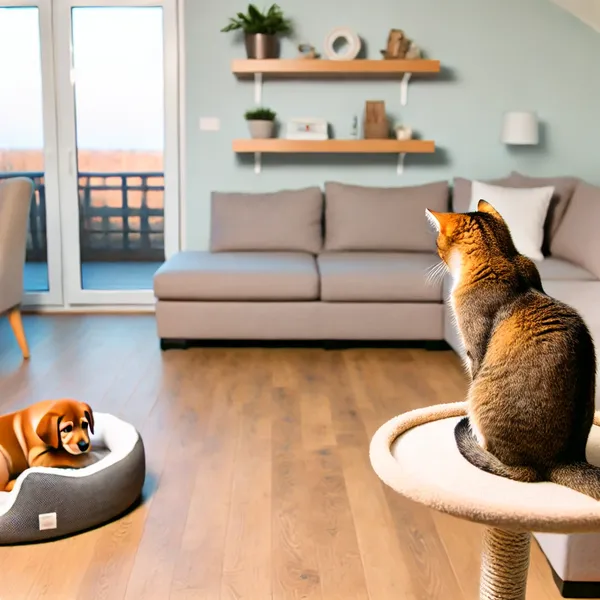
It is hard to overstate the need to prepare oneself before introducing a puppy to a cat. Kitties have their own routines and are typically wary of unfamiliar creatures; hence, some effort will help ease the introduction.
Steps to prepare:
Create safe spaces for your cat and puppy.
Give your cat a room or area where it can escape if it feels stressed. Puppies are inquisitive and active, and a cat may probably get the shock of its life the first time it sees this.
Familiarize your pets with each other’s scent.
Rub a towel or blanket on each pet and place it in the other pet’s zone. That will ease their concerns about the unseen beings as they will have their scent.
Train basic commands for your puppy.
Simple commands like sit and stay can help you control your puppy’s manners during this overwhelming mission.
By creating an outline, you are ensuring the safety and comfort of the two pets involved. That eliminates the chances of issues coming up as early as the beginning phase.
2. Begin with Auto training Exercises
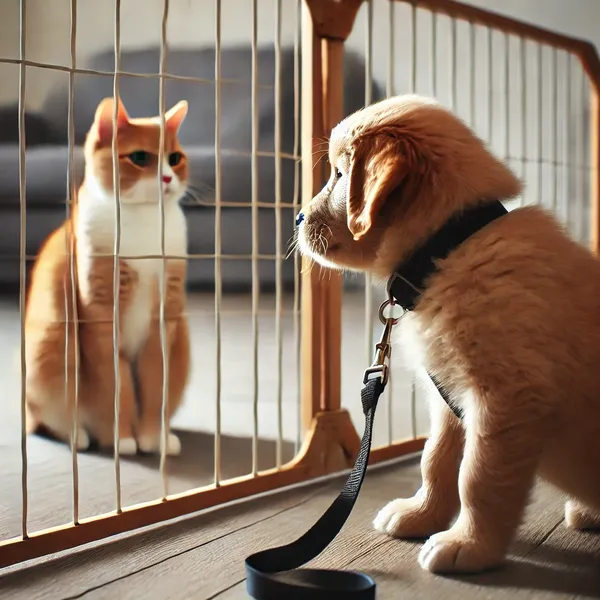
Appropriately, when the time to meet comes, ensure that your feline is calm and cool. You do not want to traumatize your feline or stress your canine.
The following is how to prepare for controlled exposure:
Put your puppy on a leash.
This will help control the puppy’s movements and withstand any puppy attacks towards the cat.
Use a baby gate or a crate. The cat can see the puppy through a gate or when the puppy is in a crate. This solves the problem of both pets being in the same place yet unable to touch one another.
Monitor their response.
Watch your puppy and your kitten interact. Your cat may start hissing or flee; this is understandable. The pup may bark or try to jump on the cat but do not let them do so.
Easier interaction should be practiced.
Basic primarily consists of only a brief five to ten minutes early on, in volume, when both your cat and puppy can get along with each other.
Tip: Both pets should be praised and rewarded for their ability to remain composed. This means giving them snacks, especially during the meeting, which helps them feel good about each other.
3. Provide Enough Time for Your Cat
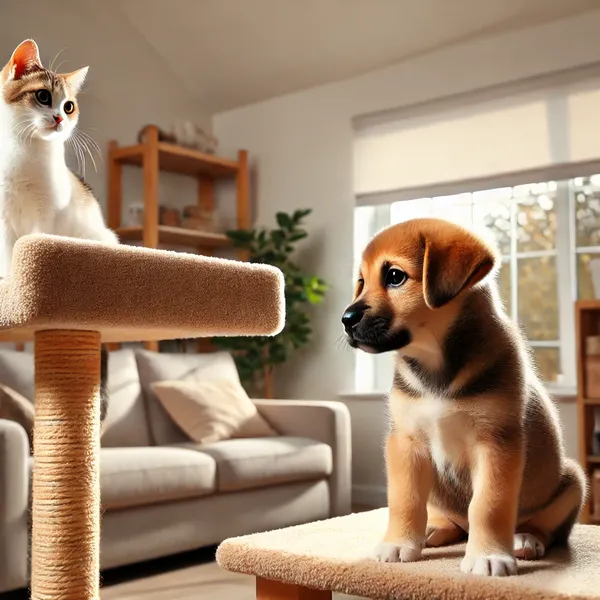
Every cat experiences an adjustment period. For example, puppies are usually excited to meet and play with any new pet, but most cats are apprehensive of other creatures. In this scenario, it would be wise to acclimate the cat to the puppy’s presence over a reasonable period.
Following are a few pointers to note:
Begin by appreciating that there is no hurry.
Most cats will need reassurance, and putting them under pressure to engage too soon would be counterproductive.
Let your cat watch the puppy without getting too close.
They might prefer to view the action from a high place or even from a different space altogether. This is a safety mechanism, especially in cats—they will move in closer when they feel it is safe.
Be on the lookout for any signs of stress from your cat.
Rapidly flicking tail, ears bent backward, or hissing indicate that the cat is likely under stress. Allow the cat to be by itself for a while to calm down.
The cat and the puppy will adapt, but to different extents, which should be understood. Permitting your cat to adjust gently minimizes the likelihood of any altercations.
4. Controlled In-Person Interactions
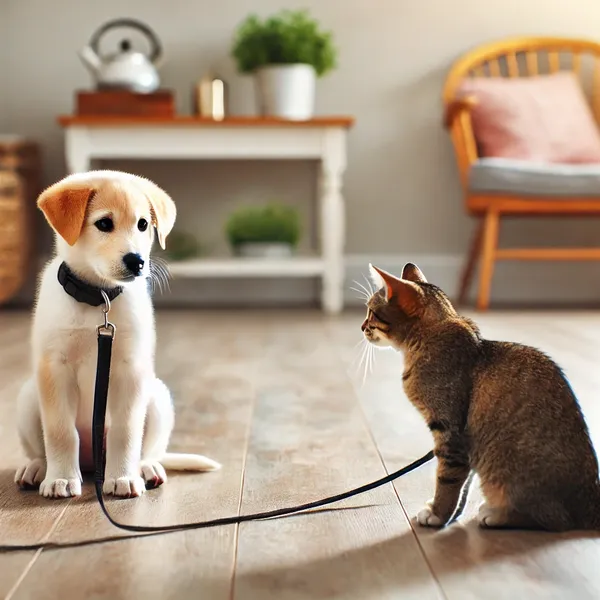
The next stage of familiarity is when your puppy and cat can finally meet each other in person without protective barriers. Such meetings should, however, still be monitored.
For the meeting to be conducted successfully, do the following:
Put a leash on your puppy.
Stop controlling your puppy only when you are sure the pets will get along in any circumstance.
Allow your cat to come to them.
Different animals will seek to advance toward the other differently, so it would be wrong to hurry the encounter.
Preferably, maintain a low profile.
Prevent any noises or quick actions that can cause fear to the pets.
Discourage rough play. If your puppy gets boisterous or tries to run after the cat, entirely give commands such as ‘sit’ or ‘stay’ and draw your puppy away. Encourage them to obey.
Patience must be practiced during face-to-face meetings, as these encounters take time. Such measures foster trust between pets.
5. Look For Reassuring Indicators
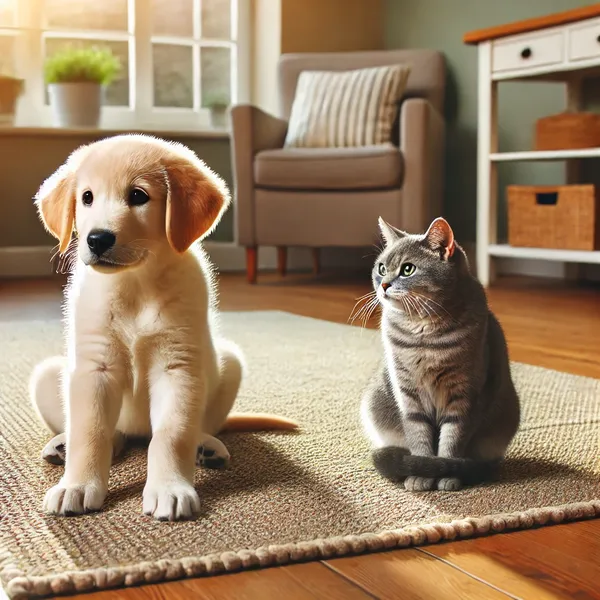
During this introductory phase, seek out any indications that your puppy and cat are forming a good bond. Positive interactions are a great indicator that things are on the right path, but they should be noted in a timely manner.
Why and where there are positive indicators:
Curiosity without an inclination to fight.
If your cat and puppy love to sniff each other, it is a beautiful sign of curiosity and acceptance.
Play behavior.
A playful tryout may also occur when a puppy sees a cat. If the cat seems friendly and joins in (swatting his paws but without claws or running away), then it shows that they are becoming friends.
They comfortably tolerated silence.
The cat and puppy occupying the same room or lying nearby indicate their acceptance levels.
Not every interaction has to meet the highest standards but as long as the aggressiveness is contained, it’s a step forward.
6. Face Issues in a Constructive Manner
On some occasions, bringing a puppy into a household with a cat tends to be challenging. Most of the time, you will encounter some challenges but don’t fret. These situations can be managed if you use the proper measures.
Some challenges, along with their solutions, are detailed herein:
- Puppy Launching After a Cat: It is quite natural for puppies to have excess energy and to seek out activities that include running. In such firms, commands like “stay” and “leave it” can be used to control the chase. Assist the puppy every time they respond to such commands.
- Cat Hissing or Swatting: Most kittens will often swat or hiss as a method of discouraging the puppy’s approach. This usually indicates that they are frightened or feeling aggressive. Better give them some time and try again after some time.
- Jealousy or Issues of Territory: Each pet will likely presume the other is after their territory or the owner’s attention. Try to ensure both pets get some quality time away from each other and have some good spots they can use to hide away.
Being calm and patient when handling issues will ease almost all problems.
7. Build a Comfortable Environment for Both Pets
In the end, following the rehabilitation period, a warm and pleasant atmosphere where your puppy and cat will reside together should be developed. Provisions must be made for each pet to hide away and recuperate separately and also for their interaction.
Suggestions for creating a peaceful home include:
Put a different bowl for each animal.
Some dogs and even cats become food-aggressive, so placing their food in other locations will be peaceful at lunchtime.
Various toys and other activities.
Providing a cage with appropriate toys for the puppy and the cat will keep them active, encourage play, and reduce boredom, preventing trouble.
Make sure there are areas for them that are their own.
Your cat may want a specific corner to curl up and nap, while your puppy may require a particular spot for its bed. Such areas should be respected, and each individual should be allowed to do so when they want to rest.
8. Exercise Patience – They Need Time To Be Friends
Bringing a puppy home to a cat is not just a one-day affair. It involves stages, and one should understand that every stage builds relationships over time. Take your time expecting them to bond as friends quickly. Some dog and cat pairs become instant friends. Others take longer to get used to each other.
This is what you can do:
Enjoy the little things.
Every site is a victory, even if it’s just some sniffing up close or sitting beside each other without fighting. Appreciate the Little Efforts of Achieving Milestones
No need to hurry.
There is no such thing as every pet behaving the same way, so in that case, every pet has their own pace.
Keep your chin up.
The more positivity you infuse into the situation, the more at ease your pets will be.
Then, eventually, your cat and puppy can be inseparable—or at least coexist kindly.
In conclusion, The first introduction of a puppy to a cat can look scary. However, it is not necessary. As can be seen from the descriptions of the steps, with time, you will manage your pets to be in good relations.
It is essential to understand that there needs to be a gap between the puppy and cat introduction, followed by a gradual introduction and plenty of rewards.
With these three ingredients, we guarantee you will have a calm puppy and a happy, contented cat in the same living area.
They will learn not only to coexist but also to form strong bonds of companionship with time and work, particularly a considerable amount of time and work.
We trust this information lets you prepare for the introduction process between your new puppy and your cat. We don’t need to rush anything so that we can take the steps and they can be our best friends for a long time!